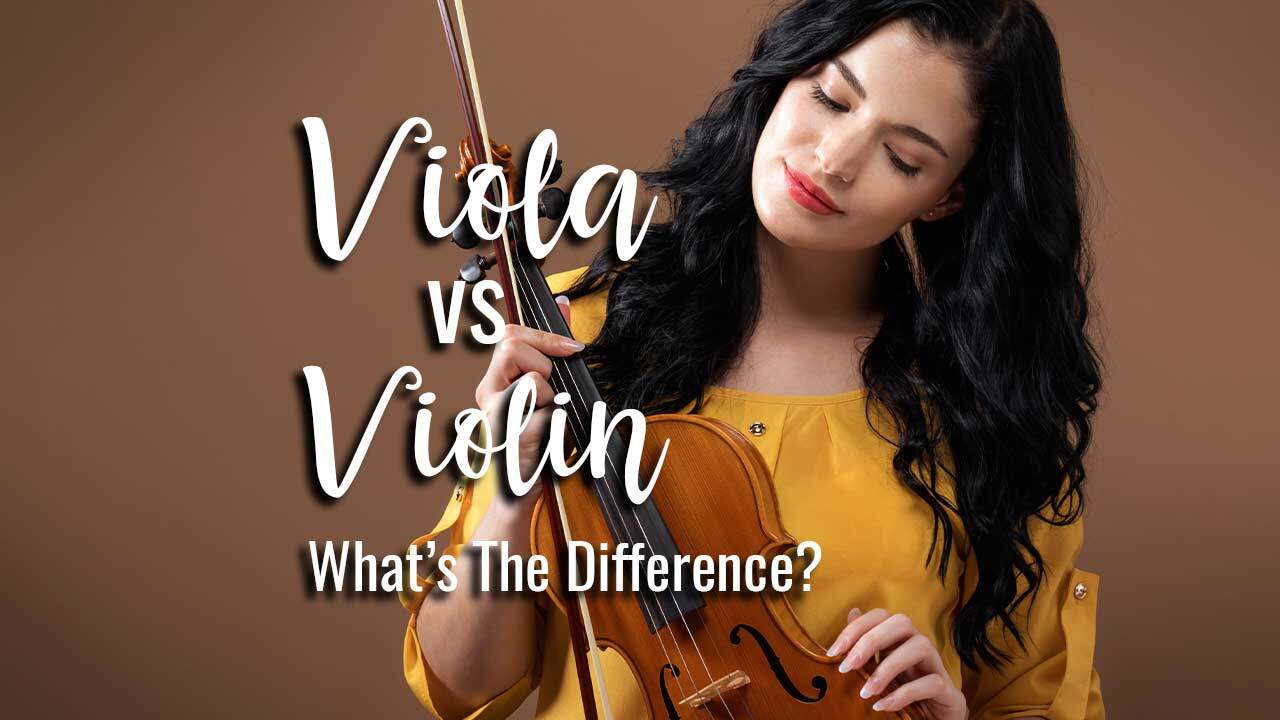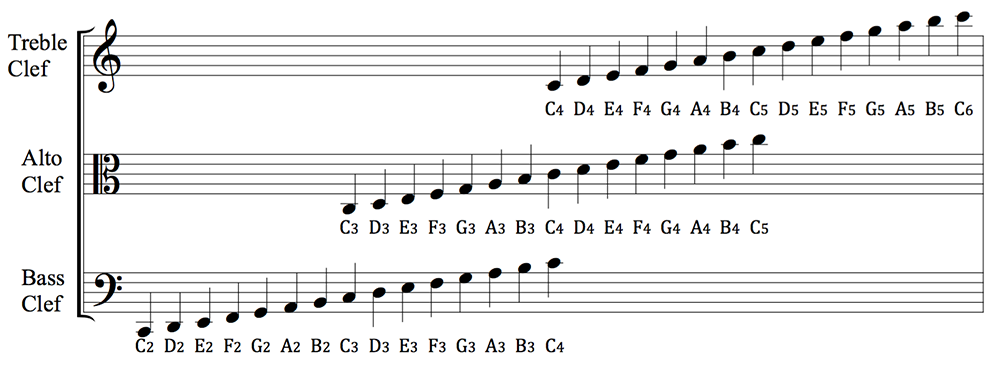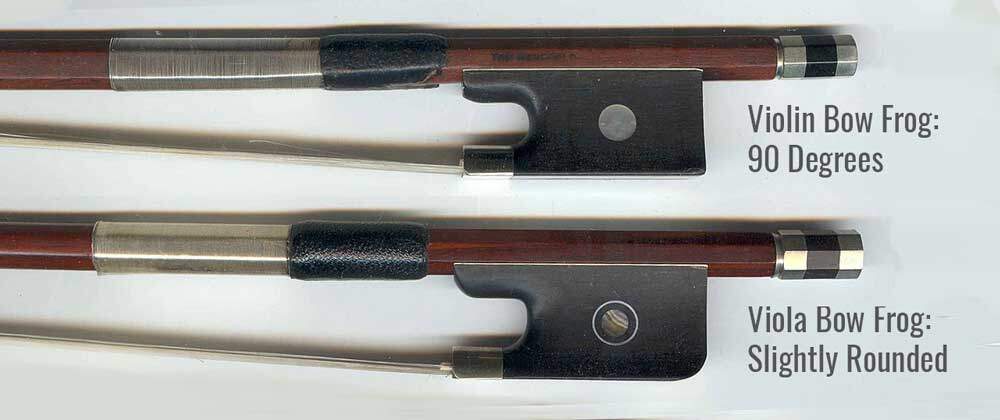If you’ve ever wondered what the difference between a viola and violin is, this article is for you. Hint: there are many! Let’s have a look at exactly what those difference are.

What is the Difference Between a Viola and a Violin?
Is Viola Deeper Than Violin?
Which is Easier Violin or Viola?
Are Violin and Viola Bows the Same?
Can Violinists Play Viola?
Can You Teach Yourself Viola?
Why is the Violin Better Than the Viola?
In Closing, Violin and Viola are Similar, Yet Very Different
![]()
Violas and violins look very similar and are played in a similar way. In fact, they are so alike that an inexperienced person may not be able to spot the differences between them just by looking. It’s the sound that separates them.
Let’s look at violins and violas, and find out which one is easier to learn, play, and enjoy!
![]()
![]()
What is the Difference Between a Viola and a Violin?
The easiest way to think of the differences between a viola and a violin is to take a step back and understand the violin family. There are actually four instruments in the family.

![]()
- The violin, which can be up to 14″ in length, is the smallest and lightest member of the family, it is also the highest in sound. The range of a violin is in the treble clef, from G3-A7
- The viola, which can be between 15″ and 18″, is constructed much like a violin, but is slightly larger and heavier The viola has an alto voice, ranging from C3-E6
- The cello is so large and heavy that it is played while resting on the ground. It is in the bass clef, an octave lower than the viola, with a range from C2-C6
- The double bass is so big that it’s often larger than the person playing it! It’s the biggest and lowest-pitched stringed instrument in a modern orchestra, with a range from C2-C5
![]()

![]()
Once you imagine all four members of the violin family in a row, from smallest and highest to largest and lowest, it’s easier to understand how the violin and the viola relate to each other. Specifically:
- The viola is larger than a violin
- The viola is heavier than a violin
- The viola is lower in range than a violin
- The viola has thicker strings than a violin
- The violin has a steeper arch in the bridge than a viola
To hear the difference between a violin and a viola, check out this video:
![]()
Is Viola Deeper Than Violin?
Yes, a viola is deeper than a violin. A viola has an alto voice, with a deeper, mellower sound than a violin. Plus the viola’s strings are thicker.
![]()
What clef does viola play in?
The voice of a viola will go deeper because its intended range is in the Alto clef. Conversely, the violin’s voice goes above middle C in the treble clef.
Another simpler way to to look at it is, the viola can play lower than a violin, but there is a good amount of overlap in both of their ranges.
![]()

![]()
In orchestration, violas often provide more rhythmic and harmonic elements compared to the vioiin’s melodic and lyrical lines.
Additionally, symphonic ensembles will typically have two violin sections versus one viola section.
![]()
Which is Easier Violin or Viola?
The truth is, both a violin and a viola have ways in which they are easier and ways in which they are harder for a beginner to learn.
- A viola is easier to learn than a violin because music written for a viola is simpler and less complicated
- For those smaller in stature, a viola may be harder to learn than a violin because the instrument and the bow are larger and heavier. Your hands have further to travel, your arm has more weight to support, and your fingers have to press harder on the strings. It requires more strength and endurance in the body
- A viola is easier to learn than a violin because the larger bow and instrument require less precision for beginners.
- A viola is harder to learn than a violin because most music for the viola is written in the alto clef, which isn’t used by many instruments. Even if you already know how to read music, you will need to adjust for the viola
Aside from the key difference in physical strength and endurance, the process of learning to play the violin versus viola is very similar.
![]()
Does Viola or Violin Appeal to Your Tastes?
When trying to choose whether to learn the violin or the viola, it’s a good idea to ask yourself:
- What kind of music do you like? The viola is essential for string quartets and chamber music, and is often used in classical, folk, Celtic, blues, and jazz music. The violin is a more diverse instrument, used in nearly every genre of music
- Which sound do you prefer? Some people love the smooth, rich tones of a viola, which sings in the range of a human voice. Some people love the high, clear notes of a violin. Choose the instrument that sounds best to you
- What kind of personality are you? Violinists are the “lead guitarists” of an orchestra. They have spectacular solos, soaring arpeggios, and a huge range of complicated, difficult, virtuoso music to play. Violas are more understated. They tend to play harmony, rather than the melody. There is less music written for the viola, and even fewer solos. The viola seldom takes center stage and commands attention. If you crave the spotlight, the violin is probably the better instrument for you. However, because the viola is a less commonly played instrument, there is less competition and it may be easier to find work
Are Violin and Viola Bows the Same?
There is a difference between a violin bow from a viola bow. Viola bows tend to have a weight ranging between 69 and 74 grams, or 2.4 and 2.6 ounces.
Violin bows on the other hand are lighter, up to 10 grams lighter on average compared to viola bows. The lighter violin bow contributes to the brighter sound the violin produces.
The viola bow being larger, requires more weight to produce sound from the relatively larger viola strings.
Additionally, viola bow frogs generally have a slight curve, whereas violin bows have straight ninety degree edges. This also has an affect on how the player draws the bow across the strings, which in turn influences how the instrument sounds.
![]()

Can Violinists Play Viola?
Yes, violinists play viola, and vice versa. The instruments, body position, fingering techniques, and music are similar enough that an experienced player can switch back and forth.
In fact, many violin instructors recommend that beginning violin players practice often with a viola, because playing the larger, heavier instrument builds strength and endurance that makes the violin easier.
Can You Teach Yourself Viola?
With time and dedication, you can teach yourself viola using the excellent information and resources available online. There are apps, YouTube channels, online instructors, books, and many other resources available to help you learn to play the viola.
However, it is always a good idea to use an online lesson platform, or tutor or instructor, who can give you real-time feedback, at least in the beginning.
![]()
![]()
Learning the viola requires the correct posture and finger techniques, bow positions, and other small factors that can be difficult to notice and master by yourself.
It is always a good idea to have that kind of feedback and correction early in your viola lessons, so that you don’t develop bad habits that are later more difficult to get rid of.
Why is the Violin Better Than the Viola?
Despite the huge number of viola jokes, the violin is not better than the viola, although it is more popular. Historically, the viola was a large, heavy instrument that was physically awkward to play.
Because it was physically difficult, the music written for viola was simpler and easier, to avoid fatiguing the player. The lower tones of a viola don’t lend themselves to solos, because the instrument doesn’t project its sound as well as a violin or a cello, so fewer composers wrote music for the viola.
This led to a reputation among orchestras of violas being an instrument that is easy to play, and violists as being lazy. Historically, the violinists are the sopranos of the orchestral world, and have a “diva”-like reputation, and they frequently teased violists.
However, many composers, including Bach, Mozart, Beethoven, Schubert, Dvorak, and Mendelssohn were themselves viola players who appreciated the sound and difficulty of the instrument, writing interesting music for it.
In the 20th century, when the viola became closer to being standardized in size and therefore physically easier to play, and modern technologies overcame some of the acoustic challenges of the viola, then more and more complex, interesting, beautiful music was created for the viola.
Today, while some of the jokes persist, the viola is a more respected instrument that has earned its place on the stage. Just listen to Rebecca Clarke’s gorgeous Viola Sonata for an example.
![]()
![]()
![]()
In Closing, Violin and Viola are Similar, Yet Very Different
If you are considering learning either the violin or the viola, listen to both of them and choose which one appeals to you more. Both instruments are beautiful, with their own unique sound and role to play in a piece of music.
The good news is, once you can play one of them, you will find it extremely easy to play the other, so it doesn’t have to be a final decision. Learning either one is a great pathway to being able to play both, and have access to a wider range of musical voices and expressions.

Leave a Reply